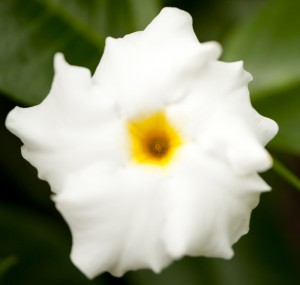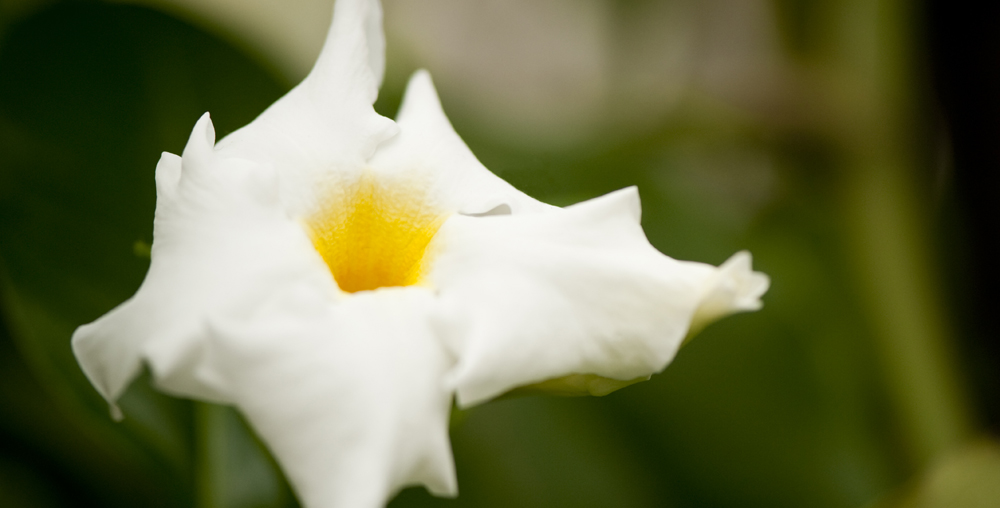How to Over-Winter a Mandevilla Vine: Following Up
Posted in Gardening Tips on October 29 2013, by Sonia Uyterhoeven
Sonia Uyterhoeven is the NYBG‘s Gardener for Public Education.
 Back in October of 2011, I answered a question a follower asked us on Twitter: “How do I overwinter a mandevilla vine?” It was simple enough to come up with an explanation at the time, but little did I know I would be receiving so many additional questions after the fact. Over the last two years, a number of Plant Talk visitors have stopped in to leave their comments and requests, which I’ll answer here.
Back in October of 2011, I answered a question a follower asked us on Twitter: “How do I overwinter a mandevilla vine?” It was simple enough to come up with an explanation at the time, but little did I know I would be receiving so many additional questions after the fact. Over the last two years, a number of Plant Talk visitors have stopped in to leave their comments and requests, which I’ll answer here.
For those who are not familiar with it, the mandevilla (Mandevilla splendens) is a Brazilian native with glossy leaves and bright, trumpet-shaped flowers. It is normally grown as a vine but occasionally pruned into an upright shrub shape. A hybrid, Mandevilla x amabilis, forms a tall vine perfect for growing on a trellis. But because these plants are not hardy in our zone, they require some special care in the cooler months. You can read all about it in my original post. In the meantime, I’ll answer the more specific questions our visitors have posed in hopes of helping your mandevilla survive the coming winter.
If you have a question that I haven’t answered here, feel free to leave it in the comments below!
Q: “I was wondering if I can put the mandevillas in a greenhouse, because I have eight of them, all in very large pots.” — Jay
A: The answer is yes, your mandevillas will be very happy in a greenhouse. Depending on the temperature and the light level, your mandevillas will either continue to grow slowly through the winter or they will go dormant, the latter of which should only happen if the temperature in the greenhouse is less than 60 degrees Fahrenheit. Keep the plants on the dry side, making sure that they do not completely dry out. The foliage will drop off and it is best to cut the vines down to about 8-12 inches. They will start to grow in spring as the weather warms.
If the greenhouse is kept at 65 degrees Fahrenheit or higher, then your mandevillas will continue to grow through the winter. If they get enough light, they will flower.
Q: “If I am removing my mandevilla from the earth to a container, what size container is a good size?” — Jennifer
A: When digging it up from the garden, place the root ball in a container that is slightly larger than the root ball. The goal is to give the roots some room to settle in but not too much. When you move a container plant and increase the pot size you can bump it up one size larger. Pot sizes usually increase by two-inch increments.
Q: “How often is ‘occasionally’ for dormant watering?” — Linda
A: You want the soil to be on the dry side but not completely dried out. The plant is dormant (inactive) but still alive, so you need to make sure that it doesn’t dry out and desiccate. Water it before you store it in the garage (or the chosen location) and check on the container once every three weeks to a month to see how it is doing. If it is being stored in a cool location, there is a good chance that it will require no or low watering (maybe once or twice during the winter).
The frequency of the watering will be determined by the light and the temperature. A container in a sunny, cool greenhouse will require a different watering regime than a garage. In that case, you will need to check more frequently.

Q: “I am losing leaves fast. What should I do?” — Fay
A: At this time of year, I am assuming that your mandevilla is going dormant and the loss of foliage is due to the seasonal change (lower temperature and light levels). If you are growing your mandevilla in a container in your home and it is losing foliage, then one option is to move it to a brighter location to see if that helps. If the plant has decided to go dormant, then it might be best to just let it do its thing (see above). If your mandevilla is losing its foliage and it is not due to the seasonal change then there could be a few possibilities.
In general, if house plants start losing foliage, check first on light level. Also look at your watering practices. Yellow leaves could be from over-watering or under-watering. Stick your finger into the potting mix and check to see if it is dry or wet. Checking an inch or two below the surface level is always wise to get a sense of the moisture level in the pot. Another reason for foliage yellowing and falling off could be a pest problem. Inspect the foliage for signs of scale, mealybugs or any common household pests. Given the time of the year, I am guessing that your mandevilla just wants to go dormant for the season.
Q: “Pruning seems to present one problem—milky sap dripping from cut ends. How do I deal with that, or can I just ignore it? Also, how do I propagate the plant?” — Ian
A: Mandevilla is in the Apocynaceae Family—the Dogbane Family. Many members of this family have a milky latex sap. The sap can be a skin irritant, so wear gloves when you are pruning your mandevilla.
There are a number of ways to propagate the vine. You can propagate it from seed—it’s best to soak the seeds for 12 hours before planting. You can also take cuttings in the spring or in the late summer from the new growth. The cuttings should be about 2-3 inches long and have two sets of leaves—remove the bottom set. Dip in rooting hormone. Use 2 parts sand to 1 part peat for your mix, or a sterile, soilless potting medium. Mist cuttings and cover. Place in indirect light with temperatures around 70 degrees Farhenheit. They will root somewhere between 1-2 months after.
You can also layer the mandevilla by taking a low lying branch and layering it in another pot. Make sure the stem has good contact with the potting soil. It will take several months for it to root. There are many excellent videos on YouTube that will show you how to take cuttings and layer.


Am I correct in assuming that mandevillas can be propagated by splitting the tubers?